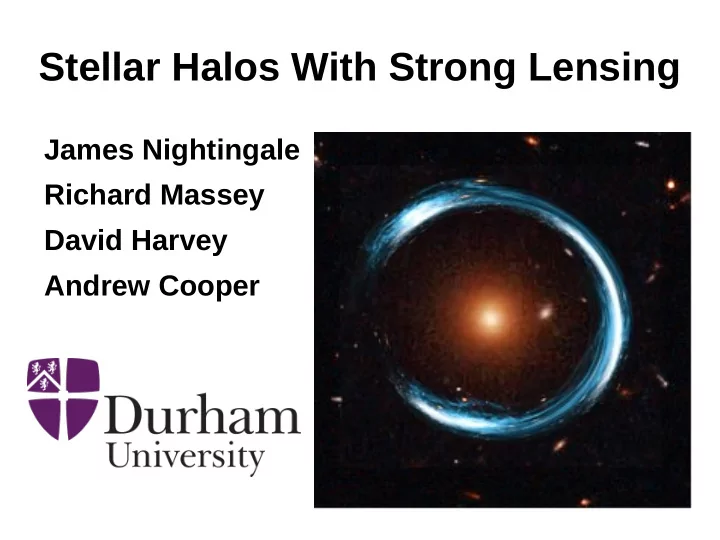

Stellar Halos With Strong Lensing James Nightingale Richard Massey David Harvey Andrew Cooper
Disclaimers ● I’m not an expert in Stellar halos. - Stumbled on the topic studying gravitational lensing.
Disclaimers ● I’m not an expert in Stellar halos. - Stumbled on the topic studying gravitational lensing. ● What we’ve done isn’t perfect. - Model parameterizations not optimal. - Analysis doesn’t fully exploit data.
Disclaimers ● I’m not an expert in Stellar halos. - Stumbled on the topic studying gravitational lensing. ● What we’ve done isn’t perfect. - Model parameterizations not optimal. - Analysis doesn’t fully exploit data. ● However, the idea is solid. - Gravitational lensing can inform us about stellar halos. - Exciting tool once we know how to use it!
‘Advanced’ Strong Lensing The 'Advanced' approach: ● Uses - The extended source ● light distribution. Measures (direct) – The ● lens's mass distribution, at the Einstein Radius, R ein . Measures (indirect) – The ● lens's mass distribution within R ein .
‘Advanced’ Strong Lensing
SLACS3 (SLACSJ1430+4105)
SLACS3 (SLACSJ1430+4105)
Modeling The Lens’s Light Negrello et al. 2014 Dye et al. 2014
Modeling The Lens’s Light Negrello et al. 2014 Dye et al. 2014
Lens Modeling Simultaneously model: ● 1) The lensed source's intrinsic light distribution. - Using an adaptive pixel-grid. 2) The lens galaxy's light profile. - using x2 elliptical Sersic profiles (Sersic + Exponential). 3) The lens galaxy's mass distribution. - Convert Sersic profiles to stellar mass density profiles (using a mass- to-light profile). - Spherical NFW profile (ellipticity not necessary). - A shear term. These models were informed using Bayesian model comparison. ●
PyAutoLens - Open-Source Lens Modeling For The Masses ● Customizable and fully automated strong lens modeling. ● Open-source software in Python. ● Check it out! https://github.com/Jammy2211/PyAutoLens
Results
Lens Sample ● 3 SLACS lenses: - z = 0.2 – 0.5 - σ = 164, 252, 322 km/s. - M dm = ~10 13 M Θ - M * = ~10 11.5 M Θ ● Abell 2102: - σ = 290 km/s.
SLACS3 (SLACSJ1430+4105)
SLACS1 (SLACS0252+0039)
SLACS2 (SLACSJ1250+1319)
Detecting Multiple Components ● Separating different light profile fits to massive ellipticals is hard. ● Compare two models: - Model with single Sersic profile (bulge) . - Model with a Sersic + Exponential profile (bulge + halo).
Light Profiles Sersic Sersic + Exponential
Light Profiles Sersic Sersic + Exponential
Light Profiles Sersic Sersic + Exponential
Light Profiles
Sersic
Sersic + Halo
Sersic + Exponential ● Component 1 → Bulge: Smaller: Effective Radius = 0.20”, 0.55”, 0.64”, 0.55” Concentrated: Sersic Index = 3.6, 3.8, 3.0, 1.39 Round: Axis Ratio (b/a) = 0.88, 0.78, 0.92, 0.84 ● Component 2 → Envelope: Extended: Effective Radius = 0.82”, 2.00”, 3.52”, 4.44” Smooth: Sersic Index = 1.0, 1.0, 1.0, 1.0 Flat: Axis Ratio (b/a) = 0.79, 0.77, 0.63, 0.6
What does Lensing Tell Us?
Mass Profiles
Stellar + Dark Mass Profiles ● Detect different mass-to-light profiles: - Halo lower M/L then bulge in one lens. - Higher M/L in another. - Gradient in mass-to-light profile of one lens. ● Direct measurement of the (inner) dark matter halo mass. - Key to understanding stellar halo formation?
Bulge-Halo Geometry ● Rotational offsets detected in all 4 lenses: 70˚ 80˚ 21 ˚ 12 ˚ . ● Centroid offsets detected in 3 lenses: 0.090 kpc 0.344 kpc 0.403 kpc.
Everything We Did Wrong
Lens Modeling The lens galaxy's light profile. ● - using x2 elliptical Sersic profiles (Sersic + Exponential). Should we switch to x3 (or more) Sersic’s? ● - Probably mixing the halo and ‘thick disk’ / ‘extended envelope. Can also target higher mass / lower redshift strong lenses. ● - More sensitivity to stellar halo.
Masking ● Our masks are huge for a lensing study! ● But embarrassingly small for a stellar halos study :(. - We can adjust our approach accordingly.
So Why Should You Care?
Future ● We’re ready to model 100+ strong lenses: - robust septation of stellar components and dark matter. - Does dark matter dictate the stellar halo? ● Completely different assumptions to other approaches. - No stellar population modeling, metallicities, cosmological dimming, PSF nastiness, background sky ambiguities..
LSST ● 10000 strong lenses: - Deep multi- wavelength data of the stellar halos. - Weak lensing data to tie to overall enviroment.
Summary ● Strong lensing can determine : - The stellar (halo) profile. - The dark matter profile. - Their geometry. ● PyAutoLens: https://github.com/Jammy2211/PyAutoLens
Recommend
More recommend